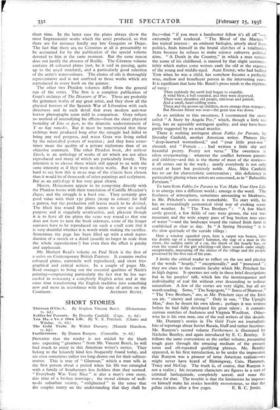POPULAR ART BOOKS
and Degas. By Camille Mauclair. (Heinemann. roe. 6d.) Paul Nash. By Herbert Read. (The Soho Gallery.)
THE Phaidon books are performing the most valuable function possible for the cause of art, but they leave the poor reviewer in a difficult position. For it grows wearisome for him to have to go on repeating that these are the best value of any art books on the market, and that the plates are many and excellently printed. His supply of laudatory adjectives is soon exhausted. So that for this new group of four in the series let us take it for granted that the books are all that they should be in the way of production' and value and think about what they contain. The plates in the Impressionist volume seem to have been chosen on a logical system so as to include those artists who belonged to the movement all their lives and also paintings by those who wet:: attached to it for a short time. In the latter case the plates always show the most Impressionist works which the artist produced, so that there are for instance hardly any late Gauguins or Degas. The fact that there are no Cezannes at all is presumably to be accounted for by the publication of the special volume devoted to him at the same moment. But the same reason does not justify the absence of Bazille. The Cezanne volume contains z8 coloured plates (not, be it said in passing, quite up to the usual standard), and a particularly good selection of the artist's water-colours. The choice of oils is thoroughly representative and is not confined to those works which are reproduced in every book on the painter.
The other two Phaidon volumes differ from the general run of the series. The first is a complete publication of Goya's etchings of The Disaiters of War. These are probably the grimmest works of any great artist, and they show all the physical horrors of the Spanish War of Liberation with such directness and in such detail that even modern anti-war horror photographs stem mild in comparison. Goya refuses no method of intensifying his effects-7-from the sheer physical bestiality of Esto es peor, to the dramatic understatement of Y no hay remedio. But it must be remembered that these etchings were produced long after the struggle had failed to bring any real progress, and , when Goya was living exiled by the reinstalled powers of reaction ; and they have some- times more the quality of a private nightmare than of an objective comment. The other Phaidon book, Art without Epoch, is an anthology of works of art which are not often reproduced and many of which are particularly lovely. The intention is to choose those which still appeal to us with the same intensity as if they were modern works. But it is very hard to see how this is more true of the objects here chosen than it would be of thousands of other paintings and sculptures. But as an anthology it has very great charm.
Messrs. Heinemann appear to be competing directly with the Phaidon books with their translation of Camille Mauclair's Degas, and the struggle is a hard one. They certainly give good value with their 13o plates (many in colour) for half a guinea, but the production still leaves much to be desired. The black line round the plates seems to serve no useful purpose and is singularly unattractive, and, pleasant though it is to have all the plates the same way round so that one does not have to turn the book sideways, some of the longer canvases have to be reproduced on such a small scale that it is very doubtful whether it is worth while making the sacrifice. Sometimes the page has been filled up with a small repro- duction of a sketch or a detail (usually no larger in scale than the whole reproduction I) but even then the effect is patchy and unpleasant.
Mr. Herbert Read's volume on Paul Nash is the first of a series on Contemporary British Painters. It contains twelve coloured plates, extremely well reproduced, and short bio- graphical and critical notices. In a couple of pages Mr. Read manages to bring out the essential qualities of Nash's painting—emphasising particularly the fact that he has suc- ceeded in remaining a completely English artist and at the same time transforming the English tradition into something new and more in accordance with the aims of artists on the

















































 Previous page
Previous page